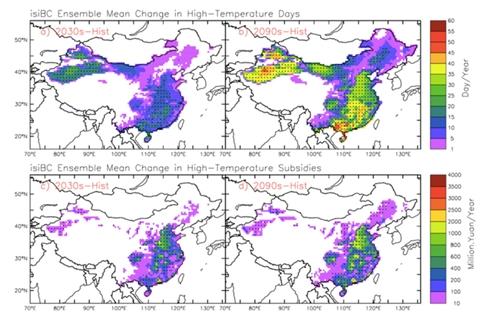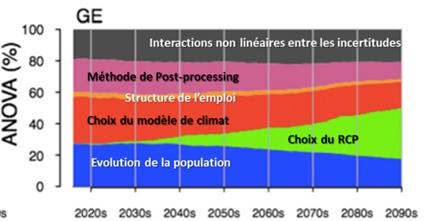[2016] Increased working costs with global warming and socio-economic changes in China
The frequency and intensity of heat waves have an impact on health. Specific indicators, involving temperature and humidity, allow to estimate a temperature felt and to link the exposure of workers to heat. In the framework of the L-IPSL, the first part of our work enabled to characterize this type of indicators on the basis of several definitions as well as their evolution on the global scale according to different scenarios of greenhouse gas emissions, aerosols and land use. From 21 CMIP5 projections under RCP8.5, we showed that thermal stress on health would increase in the 21st century, more strongly than temperature alone, and especially in the tropics, where the severity of thermal stress (characterized by the number of days above threshold values that depend on the selected indices) will reach levels never obtained so far. These results are robust despite uncertainties, which are dominated by the choice of the climate models rather than by indicators, even using bias correction methods (Zhao et al., ERL, 2015).
As a result of this initial analysis, a more focused study was carried out on China where a compensation policy for workers experiencing heat stress has been introduced since 2012. For China, climate projections suggest a very large increase in the number of days for the scenario RCP4.5 (up to 25% by 2030 and 50% by 2090, see figure 1), scenario for which human activity provides an energy surplus of 4.5Wm -2 in 2100.
The subsidy put in place in 2012 concerns Chinese workers exposed to daily temperatures exceeding 35 ° C, which amounts to increasing the cost of labor during heat waves. This subsidy is estimated at 0.2% of the gross domestic product (GDP) over the period 1979-2015. The article by Zhao et al. (PNAS, 2016) estimates the increase in labor costs associated with the increase in heat in the 21st century, by crossing several assumptions on socio-economic scenarios, population growth, employment. Under the assumption that subsidy rates remain unchanged, this subsidy could reach 3% of China's GDP by 2100.
A detailed analysis of the different sources of uncertainty, and their evolution over time, makes it possible to refine the result. The methodology relies on the analysis of variance to quantify the weight of each source of uncertainty in the total uncertainty. The different terms are estimated from all the possible trajectories that combine the different hypotheses in the estimation of the cost of the subsidy. This analysis shows that uncertainties in half of 2100 are driven by uncertainties related to modeling and climatic variability, and half by population trends and especially the choice of greenhouse gas emission trajectories (RCP, Figure 2). These methods of analysis are currently being deployed on other types of extreme weather events, such as cold spells.
Reference: Zhao Y., B. Sultan, R. Vautard, P. Braconnot, H.J. Wang and A. Ducharne, 2016: Potential escalation of heat-related working costs with climate and socio-economic changes in China. Proc. Nat. Acad. Sci., 113, 4640-4645.
Figure 1: Number of days of high temperature (top) and subsidy costs (bas) by 2030 (left) and 2090 (right) for scenario RCP4.5.
Figure 2: Estimation of the various sources of uncertainty affecting our estimate of compensation for workers exposed to heat.


